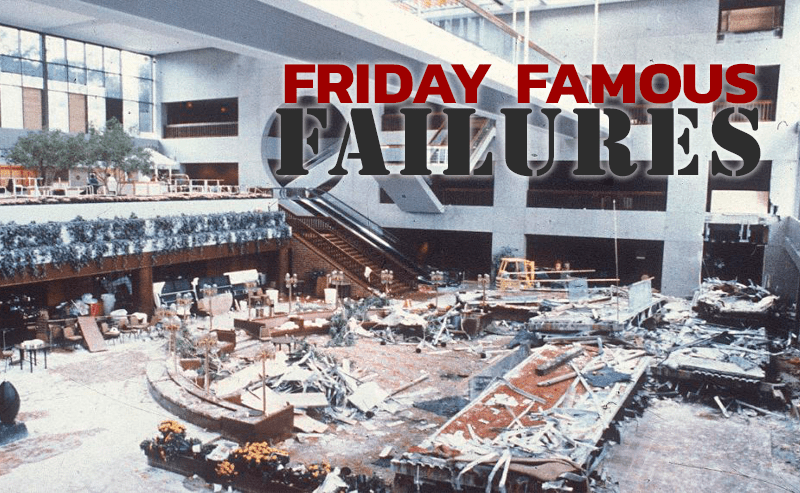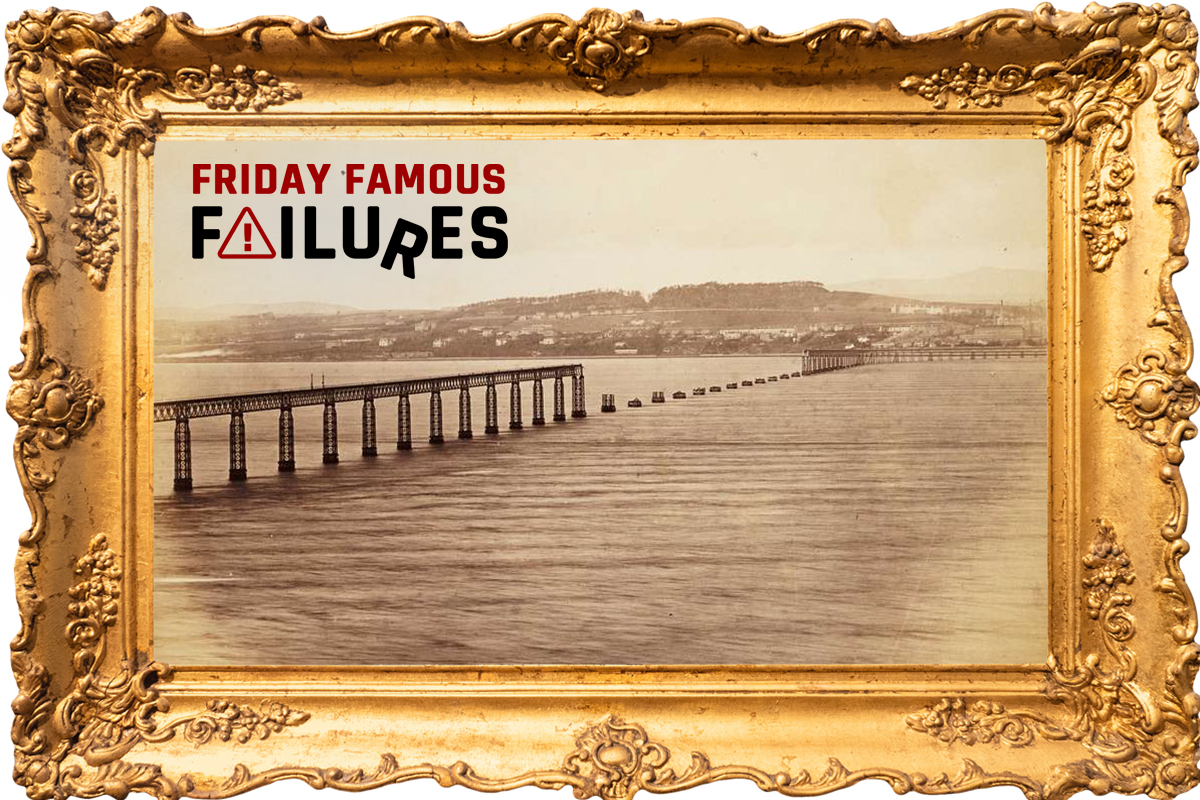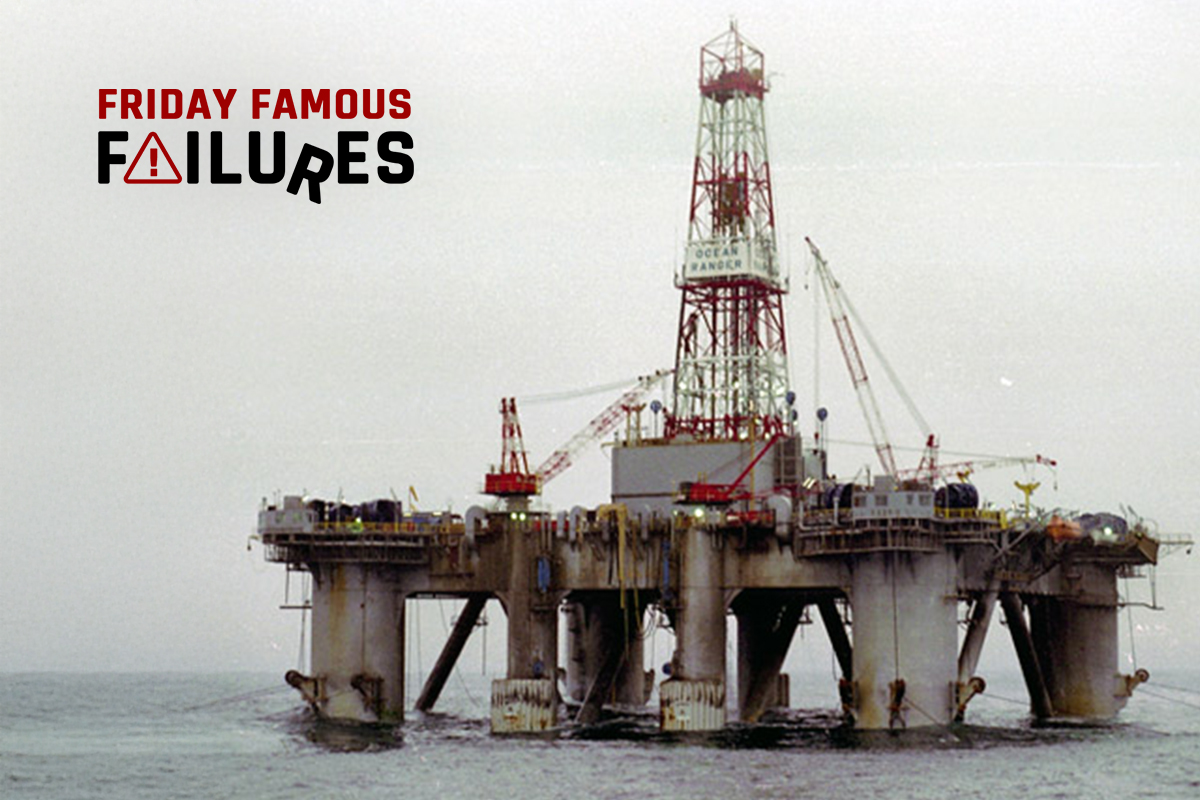On the night of July 17, 1981, the newly built Kansas City Hyatt Regency hotel was hosting a dance contest in its atrium, presented by a local radio station. Partygoers thronged the floor of the atrium and the three catwalks above, which were located on the 2nd, 3rd, and 4th floor levels. Suddenly, there was a loud crack, and the 4th floor catwalk collapsed down on the 2nd floor catwalk below it, and both fell to the floor of the atrium.
The collapse killed 114 people and injured almost 200 more, making it the deadliest structural failure in U.S. history. What caused such a deadly collapse?
Main Causal Factor: A Design Change
Before construction, the fabricator Havens identified two features of the catwalk design that would have delayed construction and made assembly of the catwalk difficult. Therefore, it made a single design change that caused the collapse.
The designer G.C.E. specified the use of long steel rods for hanging the 4th and 2nd floor catwalks from the ceiling. The catwalks were to hang one over the other, with the rods passing through the supporting beams of the 4th floor catwalk and extending down to carry the 2nd floor catwalk. The rods would extend through a box beam made by welding two C-beams together toe-to-toe, which created a hollow square tube. There was a box beam supporting each side of each catwalk.
However, such long rods were not a common material, so sourcing and using these rods would have significantly delayed construction. Additionally, the long rods would have to be threaded their entire length, as the catwalks were to be supported at each point by a nut that could be rotated to level the catwalks on the rods. This presented a significant amount of extra construction work, as the 4th floor catwalk would have to be lifted on scaffolding up a great length of the hanging rods for the nuts to be installed.
To solve these problems, Havens proposed using shorter rods to hang the 4th floor catwalk from the ceiling, and hanging the 2nd floor catwalk directly from the 4th floor catwalk on similarly sized rods. The shorter rods were more readily available, preventing sourcing delays, and eliminated the need for threading the entire rod. Havens documented this change on the fabrication schematics they sent to G.C.E. The project engineer stamped the schematics with his review seal, authorizing construction.
Later investigation concluded that because of Havens’ design change, the nuts on the 4th floor catwalk were supporting twice their design load. Originally, the nuts for each floors’ catwalk supported only the weight of that catwalk. In modifying the structure so the 2nd floor catwalk hung from the 4th floor catwalk (not the ceiling), the 4th floor catwalk nuts bore the load of both catwalks.
This kind of connection was not standard. There are a number of steel connections that have been standardized in the American Institute of Steel Construction (AISC) manual, and when an engineer specifies those connections, contractors, fabricators, and construction workers have a detailed set of instructions to follow. As a “special” (i.e., non-standard) connection, G.C.E. should have closely scrutinized the connection both in the original design phase and in the design review phase, where its modification by Havens was completely missed by the project engineer and the engineer of record.
After the collapse, Haven claimed to have called G.C.E. to notify them of the proposed change before receiving authorization, but G.C.E. disputes that they ever received such a call.
Other Causal Factors
Inadequate design: Investigators discovered that as originally designed, the catwalk structure could only support 60% of the code-required weight. With the modification by Havens, the 4th floor catwalk nuts (as constructed) could only support 30% of the required weight.
Poor weld design: In the catwalk design, the C-Beams were specified to be welded toe-to-toe, which creates a hollow square tube. It is usual to weld or bolt a bearing plate across one of the welds–especially at connecting points–to augment the welds and prevent splitting. Alternatively, if the C-Beams had been welded back-to-back to create an I-Beam cross-section, there would be much more surface area for welding and a much stronger weld.
Building code oversight: Neither the original design nor the as-built connections met building code requirements, and the city’s building inspection office was understaffed. The reviewing inspectors did not discover the design errors, and the building was certified as safe for occupancy in 1980.
Effects and Aftermath of the Disaster
The collapse occurred with many people standing on both the 2nd and the 4th floor catwalks. One of the connecting nuts on the 4th floor catwalk failed, and due to the lack of redundancy, the 4th floor catwalk fell on to the 2nd floor walkway, which subsequently collapsed and fell to the floor of the hotel atrium.
The force of the collapsing catwalks damaged water pipes under the atrium floor, which caused the hotel’s main entrance to flood. Authorities responded quickly, with more than 40 rescue vehicles converging on the hotel and helicopters transporting the injured to hospitals all over the Kansas City area. It was fortunate that a convention of doctors attending a Radiology convention was dining in the hotel’s restaurant during the collapse, so there were many doctors on-site to tend the injured in addition to first responders.
Speculation about the cause of the catwalk collapse started the very night it happened, with reporters and analysts suggesting that harmonic stress caused by people dancing on the catwalks caused the collapse. However, witnesses who recalled that the people on the catwalk were not dancing at the time of the collapse did not support this.
The Mayor of Kansas City formally requested that the National Bureau of Standards (N.B.S.), which is now the National Institute of Standards and Technology (NIST), investigate the incident. The N.B.S. determined that one of the nuts supporting the 4th floor catwalk—which was bearing twice its design load—had split the weld holding the two C-beams together into one box-shaped beam. The connection then slipped through the box-shaped beam, ceasing to provide any support. And without that nut, the 4th floor catwalk collapsed on the 2nd floor catwalk, which collapsed to the floor underneath it.
The Aftermath
Both the engineer of record and the project engineer, who worked for G.C.E., were found by the Missouri Board of Architects, Professional Engineers, and Land Surveyors to be guilty of gross negligence, misconduct, and unprofessional conduct. Both engineers lost their P.E. licenses in Missouri.
Before the board, both engineers claimed that it was Havens’ responsibility to design and check the walkway connections, despite the project engineer having stamped Havens’ shop drawings and erection drawings with his professional seal. The Board affirmed that the project engineer and the engineer of record have the ultimate responsibility to ensure that connection details are structurally sound.
After the collapse, significant changes were made in both the Kansas City Codes Administration Division and in other city code inspection departments across the country. The American Society of Civil Engineers (ASCE) announced that structural engineers are formally responsible for all aspects of structural safety in their building designs.









Were there any criminal or civil charges brought against any of the engineers or the constructor?
Heard about this when it happened and did not understand why they did not run the support rods from the second floor catwalk to the ceiling. But with the information of having to thread the full rod length, I now see the issue. They likely should have looked at doubling the rods so each carwalk would be supported by it own rods from the ceiling. This though, may not have been asticially pleasing.
Building disasters almost always result in changes to provisions in the building codes. Within a few years following this tragedy, the model codes adopted provisions requiring special inspections of structural components and connections.
Did anyone analyze the ceiling to see if it could hold the weight of both catwalks?
The ceiling would then transmit those loads down into other connections as moments, and eventually down into the foundation.
All loads have to be tracked down their load path until they dissipate into the foundation.
We studied this case when I was in college in 1982(?). By then, the cause of failure was pretty well understood and so it made for a good textbook case.
Unfortunately, there are so many different ways to make non-standard structural joints (or to turn standard joints into non-standard joints) that it’s surprising failures aren’t more frequent.
This all points to the need for engineers to inspect the as-builts to verify that they match the plans, and for engineers to have enough backbone and support to be able to say “do it over” when needed.
A few points:
First, “as originally designed, the catwalk structure could only support 60% of the code-required weight.” This says the original design was inadequate, and not just slightly inadequate so even if built to the original design it would have been a failure waiting to happen. While I realize that building code loads tend to be above the likely to happen loading, they are there because the unlikely can happen.
Second, if I recall correctly a drawing of the detail I saw years ago, there was no plate above and below the facing “C” shapes to ensure transfer of the load from the rods to the vertical portion of the “C” section. Thus, it would appear that the nut could have simply bent in the flanges and pulled through.
Third, given the connection detail, that is that the second floor walkway was supported by the fourth floor walkway, rather than the fourth floor walkway collapsing onto the second floor walkway, it is more likely that they went down together with space between them until the second floor walkway hit the bottom floor at which point the fourth floor walkway would then land on it.
Over the years I have seen several things leaving me shaking my head and saying to myself, I value my license more than that.
I visit this hotel every christmas for a church convention…don’t realize there was this history. I wouldn’t hang a catwalk with nut…I would have use bolted gusset plate work in shear or direct angle weld. It was a really bad structural design to start with.
LST Is right on target. Further, the single nut design flies in the face of redundancy and allowed a
SINGLE failure per se to cause progressive collapse. And, thinking about it? Dont know why the whole rod
had to be one piece and threaded fully or could not have the rod length been made up with a couple of couplings joining standard sized rods to obtain the total length? I am a civil engineer with a minor in structures during grad school. The stress calculation for these rods would be Strength of Materials 101 and not high tech calcs at all.
The Contractor could have used factory prefabricated tube steel (to mimic a box beam welded together) with added “built up” bearing plates welded on the underside where the nuts would be attached beneath to spread the bearing area out. Holes could be factory drilled through the tube steel per requirements for the threaded rod to pass through.
One other things bothers me, which was that speculation grew after the collapse of harmonic/natural resonant vibrations from people walking, dancing, etc., causing the collapse. I just completed a PDH course titled “Mechanical Fatigue of Metals” with another rival PDH vendor. The instructor states in this course the following:
“…Factors of Safety for fatigue loading are generally larger than in static, constant stress applications….”
If one factors in that these catwalks could be subjected to what in the above-mentioned PDH course is termed “low cycle” fatigue loading from the dynamic vibrations from people walking on the catwalks on a daily basis, then the original design may not even have been at 60% of what was required factoring in vibrational dynamic loading.